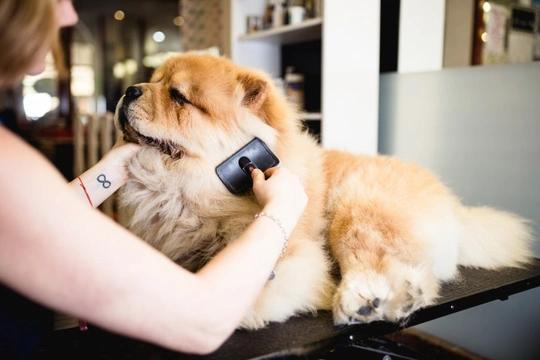
Can you clean and wash your dog’s coat without a bath?
Saying “bath time” is apt to trigger one of two reactions from dogs: Total horror, or delight at the chance of holding your full attention and having lots of fun while potentially, making a big mess at the same time! However, for dog owners, the need to bathe the dog from time to time is usually a pain rather than a fun game, even if the dog enjoys it and loves being bathed.
Not only is bathing the dog likely to be hard physical work with an uncooperative partner, you are also likely to get soaked yourself, have a large clean-up on your hands afterwards, and have to deal with your dog shaking the water out of their coat and probably zooming around the house afterwards when you are trying to dry them off too.
In order to avoid all of the potential stress and hassle that can accompany bath time for dogs, many dog owners prefer to take their pooches to the grooming parlour instead, and let a professional who has all of the right equipment, tools and experience to deal with your dog take care of things for you!
All dogs need a proper, thorough bath with hot, soapy water and manual cleaning that works right down to the skin on a regular basis-and no dog can avoid having a proper bath forever! However, if you want to reduce the frequency at which your dog needs to be bathed, tackle localised patches of dirt or keep your dog clean and smelling fresh in between baths, there are a few options at your disposal.
In this article, we will look at some of the ways in which you can clean and wash your dog’s coat without having to give them a full bath, and how to do them. Read on to learn more.
Rinsing off
If your dog has got mucky and muddy while out on a walk, you will be able to clean them more thoroughly without having to bathe them if you wash them off whilst they are still damp than by waiting for them to dry and then brushing the dirt out. Use warm water to rinse off your dog’s legs and belly, working between the legs to avoid tangles and dirt remaining in the creases of the armpits, and don’t forget to dry them thoroughly.
This should help to reduce the need for full baths.
Half-a-bath!
If your dog is small and low to the ground like the Dachshund, the chances are that their belly, undercarriage and of course, legs, will get mucky and dirty faster than the rest of them. If you can bathe these areas alone, by using a shallow bowl or tray of warm water and a shower head to wash and shampoo the bottom half of their body only, you will be able to leave them longer between full baths.
Cleaning localised areas
If your dog has got something mucky, sticky or disgusting like fox poo on them by means of rolling in it or by coming into contact with something nasty on a certain area of their body, you might want to simply wash this localised area rather than going to the trouble of a full bath.
You will still need to shampoo and rinse your dog right down to the fur in the area in question, but you can do this in the manner of a sponge bath with a bowl or sink rather than by having to immerse or shower your dog to get them clean.
Brushing and grooming
Brushing and grooming your dog helps to distribute oil from the roots of the hair to the ends, stimulate the circulation and remove dirt and dead skin cells from the coat, and a dog that is brushed properly right down to the skin on a regular basis will need to be bathed less often than a dog that is left to their own devices.
Cleansing wipes
Dog-specific or pet-safe cleaning wipes-like baby wipes, but for dogs-can be invaluable at removing surface muck and grime, and wiping away dirt and debris before they have the chance to penetrate the coat and settle onto the skin.
Some dog wipes are antibacterial too, which can help to neutralise odours-but take care not to overuse antibacterial wipes, because they also kill the natural bacteria that helps to protect your dog’s skin, which can actually worsen smells and cause other problems over time.
An oatmeal mask
Finally, there is a natural and rather innovative way to clean your dog’s coat and skin without water if they have short, fine fur, and it works on the same principle as human face masks that are left to dry on the skin and then peeled off, taking grime and dead skin cells with them!
All you need is plain, unsweetened oatmeal flakes, which you mix with hot water to make a thick paste, then leave to cool until it is just warm before working it into your dog’s coat and skin in the required area and leaving it to dry. This will only work if you can stop your dog from trying to eat the oatmeal itself though!
Once the oatmeal has dried on the skin, brush it back out of the coat, getting right down to the skin, and it will take all of the dirt and dead skin cells from the coat with it.



